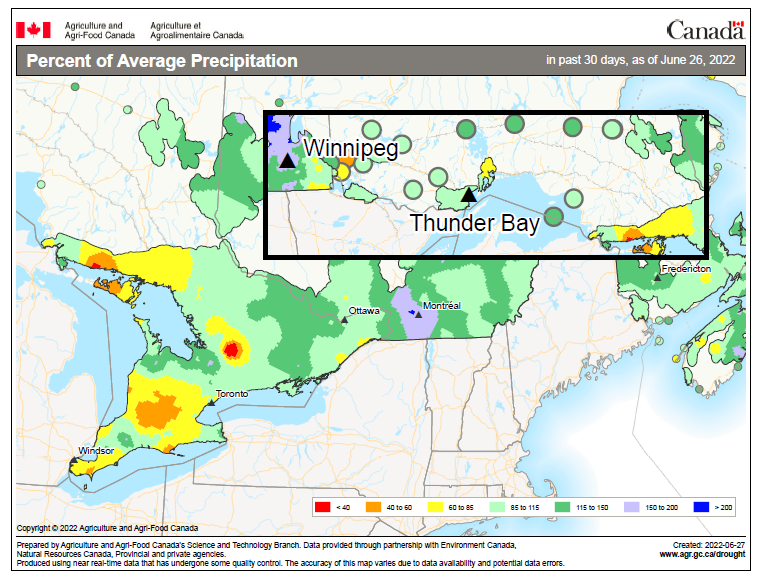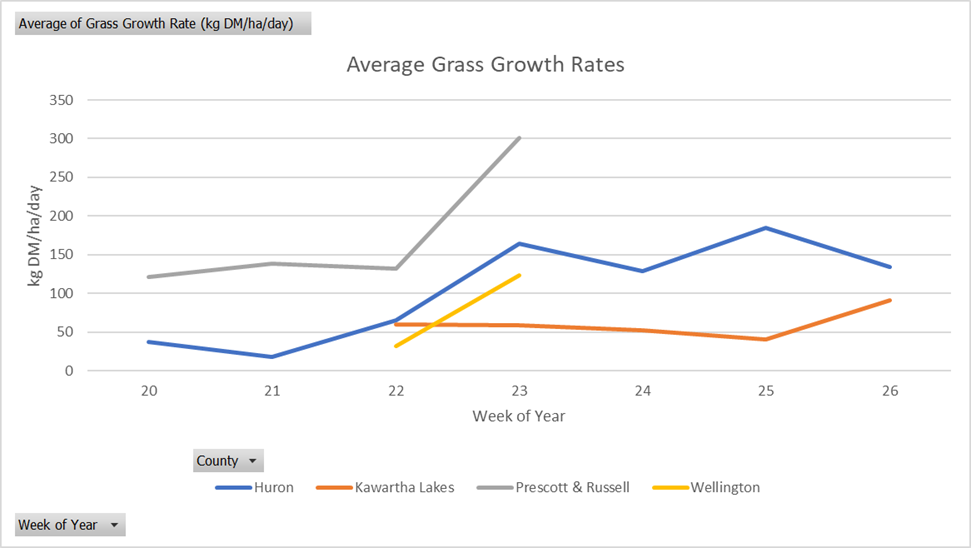
South and West
- According to Agriculture and Agri-Food Canada: Bruce, Grey, Dufferin, Simcoe, Niagara, Elgin, and parts of Lambton and Middlesex received average or above average precipitation for June. The rest of the region had below-average rainfall.
- Above-average levels of winterkill reduced yields in affected fields. Although some dairy producers cut on their preferred calendar date, harvest didn’t begin in earnest until the first week of June.
- Many fields that were cut in May had issues with alfalfa weevil in the regrowth. It is likely that the cool, dry start to the spring enabled the weevils to get ahead of the fungus that usually keeps populations in check. The recent hot, humid weather will bring on the fungus and complicate spray decisions. 3rd and 4th instar larvae that are yellow/tan in colour or lethargic are dying of a fungal infection and do not count towards threshold.
- Potato leafhopper has been found in the region. Producers are encouraged to scout weekly, as this pest can rapidly multiply under the right conditions. Information on scouting potato leafhopper is available here.
Central and East
- According to Agriculture and Agri-Food Canada: Hastings, Lennox & Addington, Lanark, and Renfrew counties received above-average rainfall for June. Muskoka was drier than normal, while the rest of the region received average precipitation.
- Reports suggest first cut yields in the region are excellent.
- While haylage came off in good time, the easternmost counties have not had many windows for making dry hay, so quality may suffer. Counties between Toronto and Prince Edward County have had more opportunity to dry hay.
- Alfalfa weevil were prevalent in first cut.
- Potato leafhopper has been found in the region. Producers are encouraged to scout weekly, as this pest can rapidly multiply under the right conditions. Information on scouting potato leafhopper is available here.
Northeast
- According to Agriculture and Agri-Food Canada: Manitoulin and Sudbury districts had below average rainfall for the month, while the rest of the region received average or above-average precipitation.
- Nipissing and Algoma districts have been getting frequent rains, making hay harvest challenging.
Northwest
- According to Agriculture and Agri-Food Canada: rainfall across the region was normal for June.
- Conditions have been favourable for grass growth. Producers are encouraged to scout for true armyworm in grassy and mixed forage stands. Use the “mixed forage” thresholds outlined here.
Pasture Production
Four pasture sites across Ontario are participating in a precision agriculture project to use grass more efficiently. Each week grass growth rates, among other production metrics, are measured using a rising plate meter. Average daily grass growth rates are shared publicly, while more detailed information is available to participating pasture managers. Year-to-date grass growth rates are shown in Figure 2.

Many thanks to Living Lab – Ontario, Ontario Beef Research Centre – Elora, Victoria County Community Pasture, and la Ferme d’éducation et de recherche du Campus d’Alfred (FERCA) for their involvement in this project.
